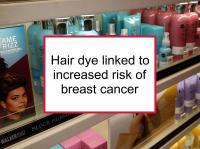The possibility of a link between hair dye and cancer has been the topic of numerous studies. There is limited evidence that dyes, especially dark dyes, might increase the risks of certain cancers. There also is evidence of an association between working as cosmetologist or beautician and increased cancer risk, including breast cancer.
However, while a few older studies reported an association between hair dye use and breast cancer risk, most did not find an association, and the question appeared to be settled. Now a large new study has reported that Finnish women who use hair dyes have a 23% higher risk of breast cancer than those who do not.
Latest research finds hair dye use linked to higher BC risk
The retrospective case-control study referenced above was designed to investigate whether use of hair dyes is associated with increased risk of breast cancer. Remnants of prohibited aromatic amines (a class of chemicals found as byproducts of the manufacturing of polyurethane foams, dyes, pesticides, and pharmaceuticals) have been found in many hair dye preparations. Heightened levels of DNA adducts of these amines have been detected in breast tissue of hair dye users. DNA adducts form when DNA bonds to a chemical mutagen. The binding of reactive carcinogens to DNA is considered the initiating event in chemical carcinogenesis. However, the International Agency for Research on Cancer (IARC) Working Group report on hair dye has concluded that there is not enough evidence to conclude that personal hair dye use is carcinogenic.
The study included 6,567 Finnish breast cancer patients diagnosed between 2000 and 2007 and aged 22 to 60 years, as well as 21,598 matched controls. Participants completed a self-administered questionnaire concerning hair dye use and other factors. Results were adjusted for known variables that could influence breast cancer risk. Women who used hair dyes were found to have a 23% higher risk of breast cancer compared to those who did not. Users of hair dye born before 1950 experienced a 28% increase. Breast cancer risk increased as cumulative use of hair dyes increased.
The authors conclude that use of hair dyes is associated with breast cancer incidence, according to this data. The authors note that a possibility of bias cannot definitively be ruled out and a prospective study is warranted. Based on the present results, however, it may be concluded that the safety of hair dyes in relation to breast cancer has not been firmly established, according to the authors.
